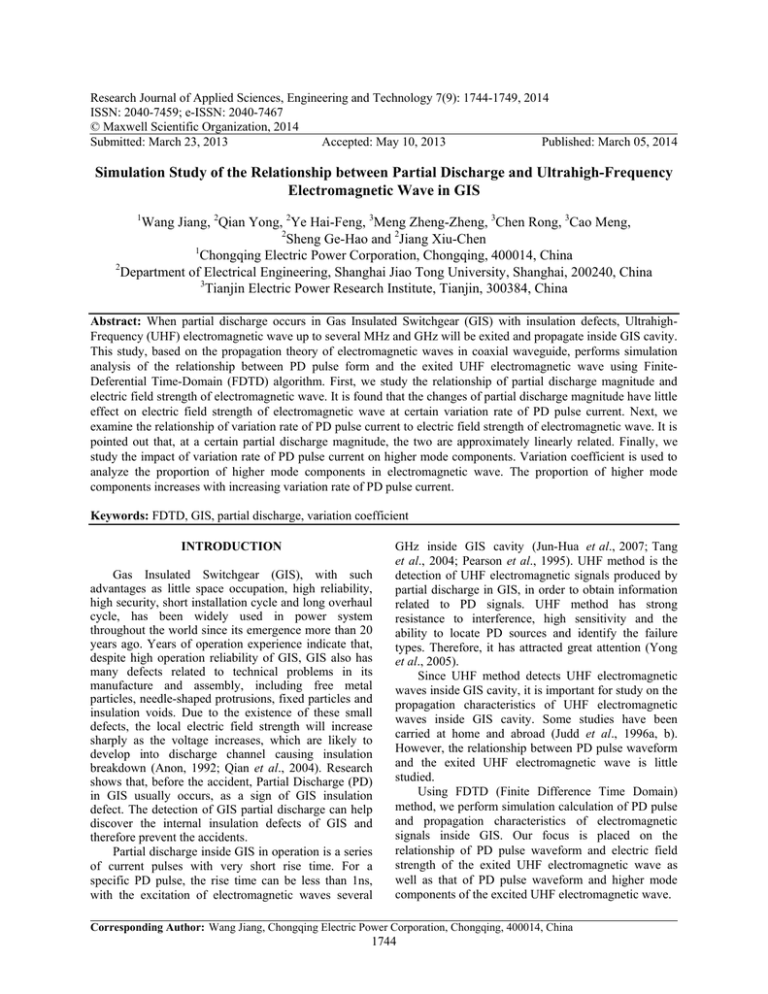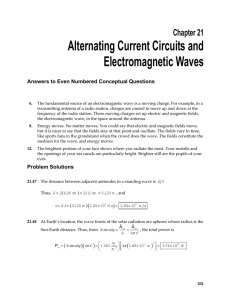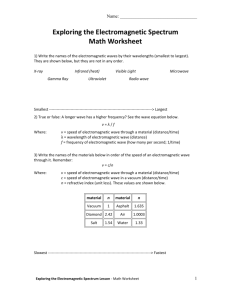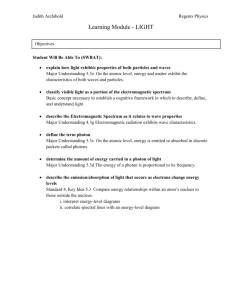Research Journal of Applied Sciences, Engineering and Technology 7(9): 1744-1749,... ISSN: 2040-7459; e-ISSN: 2040-7467
advertisement

Research Journal of Applied Sciences, Engineering and Technology 7(9): 1744-1749, 2014 ISSN: 2040-7459; e-ISSN: 2040-7467 © Maxwell Scientific Organization, 2014 Submitted: March 23, 2013 Accepted: May 10, 2013 Published: March 05, 2014 Simulation Study of the Relationship between Partial Discharge and Ultrahigh-Frequency Electromagnetic Wave in GIS 1 Wang Jiang, 2Qian Yong, 2Ye Hai-Feng, 3Meng Zheng-Zheng, 3Chen Rong, 3Cao Meng, 2 Sheng Ge-Hao and 2Jiang Xiu-Chen 1 Chongqing Electric Power Corporation, Chongqing, 400014, China 2 Department of Electrical Engineering, Shanghai Jiao Tong University, Shanghai, 200240, China 3 Tianjin Electric Power Research Institute, Tianjin, 300384, China Abstract: When partial discharge occurs in Gas Insulated Switchgear (GIS) with insulation defects, UltrahighFrequency (UHF) electromagnetic wave up to several MHz and GHz will be exited and propagate inside GIS cavity. This study, based on the propagation theory of electromagnetic waves in coaxial waveguide, performs simulation analysis of the relationship between PD pulse form and the exited UHF electromagnetic wave using FiniteDeferential Time-Domain (FDTD) algorithm. First, we study the relationship of partial discharge magnitude and electric field strength of electromagnetic wave. It is found that the changes of partial discharge magnitude have little effect on electric field strength of electromagnetic wave at certain variation rate of PD pulse current. Next, we examine the relationship of variation rate of PD pulse current to electric field strength of electromagnetic wave. It is pointed out that, at a certain partial discharge magnitude, the two are approximately linearly related. Finally, we study the impact of variation rate of PD pulse current on higher mode components. Variation coefficient is used to analyze the proportion of higher mode components in electromagnetic wave. The proportion of higher mode components increases with increasing variation rate of PD pulse current. Keywords: FDTD, GIS, partial discharge, variation coefficient INTRODUCTION Gas Insulated Switchgear (GIS), with such advantages as little space occupation, high reliability, high security, short installation cycle and long overhaul cycle, has been widely used in power system throughout the world since its emergence more than 20 years ago. Years of operation experience indicate that, despite high operation reliability of GIS, GIS also has many defects related to technical problems in its manufacture and assembly, including free metal particles, needle-shaped protrusions, fixed particles and insulation voids. Due to the existence of these small defects, the local electric field strength will increase sharply as the voltage increases, which are likely to develop into discharge channel causing insulation breakdown (Anon, 1992; Qian et al., 2004). Research shows that, before the accident, Partial Discharge (PD) in GIS usually occurs, as a sign of GIS insulation defect. The detection of GIS partial discharge can help discover the internal insulation defects of GIS and therefore prevent the accidents. Partial discharge inside GIS in operation is a series of current pulses with very short rise time. For a specific PD pulse, the rise time can be less than 1ns, with the excitation of electromagnetic waves several GHz inside GIS cavity (Jun-Hua et al., 2007; Tang et al., 2004; Pearson et al., 1995). UHF method is the detection of UHF electromagnetic signals produced by partial discharge in GIS, in order to obtain information related to PD signals. UHF method has strong resistance to interference, high sensitivity and the ability to locate PD sources and identify the failure types. Therefore, it has attracted great attention (Yong et al., 2005). Since UHF method detects UHF electromagnetic waves inside GIS cavity, it is important for study on the propagation characteristics of UHF electromagnetic waves inside GIS cavity. Some studies have been carried at home and abroad (Judd et al., 1996a, b). However, the relationship between PD pulse waveform and the exited UHF electromagnetic wave is little studied. Using FDTD (Finite Difference Time Domain) method, we perform simulation calculation of PD pulse and propagation characteristics of electromagnetic signals inside GIS. Our focus is placed on the relationship of PD pulse waveform and electric field strength of the exited UHF electromagnetic wave as well as that of PD pulse waveform and higher mode components of the excited UHF electromagnetic wave. Corresponding Author: Wang Jiang, Chongqing Electric Power Corporation, Chongqing, 400014, China 1744 Suppose that the path of partial discharge is a radial line extending from (r 1 , 0, 0) to (r 2 , 0, 0) (Fig. 2), then the electric field strength of each type of electromagnetic wave at any point (r, Ф, Z) is given by: 2a 2b Res. J. Appl. Sci. Eng. Technol., 7(9): 1744-1749, 2014 ErTEM = Z 0 ln(r2 / r1 ) I (ω )e − jω z / c 4π b ln(b / a ) ErTEnm = Fig. 1: Simplified test model of GIS (1) n2 Z0 2 − n2 ) π aJ n (qnm )(qnm r2 J n (qnm r '/ a ) dr 'cos nφ I (ω ) FTEnm (ω ) r' r1 ×∫ ErTMnm = r2 (2) Z 0 (2 − δ 0n ) 2π aJ n' ( pnm ) pnm ×[ J n ( pnm r2 / a ) − J n ( pnm r1 / a )]cos nφ I (ω ) FTMnm (ω ) (3) r1 where, i FTEnm (ω ) = Fig. 2: Path of PD current in GIS Propagation theory of electromagnetic wave in coaxial waveguide: Single-phase GIS can be simplified into a coaxial waveguide with inner diameter of 2a and outer diameter of 2b (Fig. 1). According to electromagnetic wave theory, there are also higher mode transverse waves apart from Transverse Electromagnetic Wave (TEM). Higher mode transverse wave can be divided into Transverse Electric wave (TE) and Transverse Magnetic wave (TM). They respectively propagate in frequency range higher than cut-off frequency. The cut-off frequencies of higher mode transverse waves are determined by the size of coaxial waveguide and the propagation medium. Electromagnetic waves excited by PD pulse in GIS contain TEM, TE and TM waves, which should be respectively studied. Cylindrical coordinate system is used to describe PD pulse and the excited UHF electromagnetic wave. To perform complete analysis and calculation of propagation characteristics of electromagnetic waves inside coaxial waveguide, i r , i Ф and i z which are the components of partial discharge in all directions, together with E r , E Ф and E z which are the components of the excited electric field in all directions, should be considered. Since the electric field excited by partial discharge in GIS is radial, partial discharge current tends to develop radially. In actual applications, UHF sensors are usually installed on GIS shell. On the outer wall of coaxial waveguide, E Ф and E z tend towards zero to satisfy the boundary conditions of electric field (Qian et al., 2004; Yong et al., 2005). For these reasons, we only study i r and E r in this study. FTMnm (ω ) = −ω 2 ω 2 − ωnm 2 − ω 2 − ωnm ω e e j j z 2 ω 2 −ωnm c z 2 ω 2 −ωnm c (4) (5) where, I (ω) = The expression for the frequency domain of PD pulse current = The wave impedance of the propagation Z0 medium = The n-order Bessel function of the first kind Jn pnm = The m-th root of J n = 0 qnm = The m-th root of J n ’ = 0 ω nm = The cut-off angular frequency of higher mode transverse mode FDTD ALGORITHM FDTD algorithm is adopted for simulation calculation of propagation characteristics of electromagnetic waves inside GIS. FDTD algorithm differentiates Maxwell’s equations to solve the problems of the propagation and reflection of electromagnetic wave in the medium. The basic procedures are as follows: Yee cells are used to calculate the nodes in regional space; then Maxwell rotation equation is discretized using central difference approximation and calculated using alternate sampling. Yee cells, which reflect the spatial arrangement of nodes in electric and magnetic fields in FDTD discretization, are shown in Fig. 3. We can see that each component of magnetic field is surrounded by four components of electric field. 1745 Res. J. Appl. Sci. Eng. Technol., 7(9): 1744-1749, 2014 Moreover, FDTD algorithm is performed with absorbing boundary conditions. Therefore, the calculation proceeds in finite spatial range (Pearson et al., 1995). In doing this, we bring down the demand of program on computer hardware. Ey Hz Ex Ex Ez Ey Ez ESTABLISHMENT OF GIS SIMULATION MODEL Hy Ez GIS simulation model used in this study is shown in Fig. 4. The conductor in this model has diameter 2a = 0.1 m, shell’s inner diameter 2b = 0.5 m and cavity length L = 3 m. This study does not deal with the attenuation and reflection characteristics of electromagnetic wave inside GIS cavity. Therefore, the model contains no support insulator and no caps on two ends of the cavity so as to reduce the attenuation and reflection of electromagnetic wave. At one end of GIS model (i.e., z = 0, Ф = 0), we build a radial discharge channel close to the inner conductor, in order to simulate the discharge of needleshaped protrusions on the inner conductor. The discharge channel has the length of l = 15 mm. In order to monitor electromagnetic signals in various positions inside GIS cavity, a pair of electric field probes is respectively placed at 1, 1.5 and 2 m, respectively away from PD source. Each pair of probes is, respectively at Ф = 0 and Ф = π/2. The No. of each probe is given in Table 1. Hx z Ey Ex y x Fig. 3: Yee-cell in FDTD Similarly, each component of electric field is surrounded by four components of magnetic fields. Electric field and magnetic fields are alternately sampled at an interval of half step length. Thus, Maxwell rotation equation is discretized into explicit differential equation, which can be iteratively solved. Given the initial value of electromagnetic problem, FDTD algorithm can be used to obtain the distribution of electric and magnetic fields in space at each time moment in a stepwise manner. 3m Probe 5 Probe 6 0.1m 0.5m Probe 4 PD source Probe 1 Probe 2 Probe 3 (a) Simulation model Probe 4~6 PD source Probe 1~3 (b) The positions of probes Fig. 4: The simulation model of GIS and the positions of probes 1746 Res. J. Appl. Sci. Eng. Technol., 7(9): 1744-1749, 2014 Table 1: Position and No. of each probe Ф/Z 1m 1.5 m 0 Probe 1 Probe 2 Probe 4 Probe 5 π/2 2m Probe 3 Probe 6 i RELATIONSHIP OF PD PULSE WAVEFORM AND ELECTRIC FIELD STRENGTH OF ELECTROMAGNETIC WAVE Research shows that PD signals in GIS are current pulses with very sharp rising edge and large di/dt ratio. In order to simplify the calculation while reflecting the basic characteristics of PD current, we adopt symmetrical triangular pulses with equal rise time and fall time to simulate PD signals (Shinya et al., 2006) (Fig. 5): The mathematical expressions are as follows: kt 0 ≤ t ≤ ∆t i (t ) = − kt + 2k ∆t ∆t < t ≤ 2∆t 0 t > 2∆t 2Δt t Fig. 5: Simulation waveform of PD (6) where, k = The slope of triangular pulse, i.e., di/dt Δt = The rise time and fall time of triangular pulse, i.e., t r = t f = Δt discharge capacity q = The area enclosed between triangular pulse and time axis We examine the relationship of the peak of electric field strength of electromagnetic wave-peak value E pp to discharge magnitude q at a certain value of k. From Eq. (6), we know that when the value of k is fixed and q varies, PD pulse waveform is a series of similar triangles. Simulation calculation is performed at q (pc) = 10, 20, 30, 40 and 50. At probe 2, we obtain the relationship of q and E pp with different values of k (Fig. 6). The figure shows that, for each value of k, when q increases from 10 to 50 pc, discharge capacity varies by 5 times, whereas the peak of electric field strength-peak value E pp only increases by a very small margin, i.e., less than 30%. We can observe similar variation pattern for other probes. The simulation results suggest that, at a certain variation rate of PD pulse current, the changes of discharge capacity have little impact on electric field strength of electromagnetic wave. Using similar method, we study the relationship of E pp to the variation rate of PD current k at certain q. From Eq. (6), we know that, when the value of q is fixed and the value of k varies, PD pulse waveform is a series of triangles with identical area but variable widths. Simulation calculation is performed at k (A/ns) = 0.01, 0.02, 0.03 and 0.04, respectively. The Fig. 6: Relationship between E-filed peak to peak value (Epp) and discharge magnitude (q) Fig. 7: Relationship between E-field intensity peak-peak value (Ep-p) and PD pulse current changing rate (k) relationship between k and E pp at various values of q is obtained at probe 7 (Fig. 7). When the value of q is fixed, E pp and k are approximately linearly related. The simulation results show similar variation pattern for other probes. It is thus indicated that, in GIS cavity, the variation rate of PD pulse current di/dt has great impact on electric field strength of the excited electromagnetic wave. IMPACT OF PD PULSE WAVEFORM ON HIGHER MODE WAVES As previously discussed, PD pulse excites not only TEM wave but also higher mode waves, namely, TE 1747 Res. J. Appl. Sci. Eng. Technol., 7(9): 1744-1749, 2014 CONCLUSION Fig. 8: Relationship between CV of Epp Φ = 0 and Φ = π/2 and PD pulse current changing rate (k) wave and TM wave. From Eq. (1)-(3), we know that the propagation of TEM wave in GIS is only related to radial r but not to the angle between the monitoring point and PD source Φ. However, it is just the contrary for TE wave and TM wave. Therefore, when z and r are constant, the changes of electric field strength of electromagnetic wave at different Φ are caused by TE wave and TM wave. Therefore, we can compare the differences of electric field strength of electromagnetic wave at different Φ to study the proportion of higher mode components. Variation Coefficient (CV) of electric field strength of electromagnetic wave excited by different PD pulse waveforms is compared at Φ = 0 and Φ = π/2 to study the relationship of PD pulse waveform to higher mode components. According to statistical estimation theory, with larger CV, there is larger difference among the samples by comparison of CV of E pp at Φ = 0 and Φ = π/2, we can effectively estimate the proportion of higher mode waves. The expression for CV is as follows: ( E pp 0 − E ppa ) 2 + ( E ppπ / 2 − E ppa ) 2 2 E ppa CV = (7) where, E ppa = E pp 0 + E ppπ / 2 2 (8) Simulation calculation is performed at k (A/ns) = 0.01, 0.02, 0.03 and 0.04 respectively. The relationship between k and CV at different values of q is obtained at probe 2 and 5 (Fig. 8). When the value of q is fixed, CV increases with as k increases. We also observe similar variation pattern for other probes. Then we can see that in GIS, the proportion of higher mode component increases with the variation rate of PD pulse current di/dt in GIS. We perform FDTD algorithm to study the relationship of PD pulse waveform and electromagnetic wave in GIS. The relationship among electric field strength of electromagnetic wave, discharge capacity and variation rate of PD pulse current is analyzed. Furthermore, variation coefficient is introduced to study the relationship of PD pulse waveform and higher mode components of excited electromagnetic wave. The results of simulation calculation show that: • • • When the variation rate of PD pulse current is constant, discharge capacity has little impact on electric field strength of electromagnetic wave. The variation rate of PD pulse current has great impact on electric field strength of electromagnetic wave. When PD magnitude is constant, the two are approximately linearly related. The proportion of higher mode waves in electromagnetic wave increases with increasing variation rate of PD current. ACKNOWLEDGMENT This study is supported by National High Technology Research and Development Program (863 Program) under Grant No. SS2012AA050803. REFERENCES Anon, 1992. Partial discharge testing of gas insulated substations. IEEE T. Power Deliver., 7(2): 499-506. Judd, M.D., B.F. Hampton and O. Farish, 1996a. Modelling partial discharge excitation of UHF signals in waveguide structures using Green’s functions. IEE Proc. Sci. Meas. Technol., 143(1): 63-70. Judd, M.D., O. Farish and B.F. Hampton, 1996b. The excitation of UHF signals by partial discharges in GIS. IEEE Trans. Dielect. Elec. Insul., 3(2): 213-228. Jun-Hua, L., W. Jiang, Q. Yong, D. Da-Peng, H. Cheng-Jun, et al., 2007. Simulation analysis on the propagation characteristics of electromagnetic wave in GIS. High Volt. Eng., 33(8): 139-142. Pearson, J.S., O. Farish, B.F. Hampton, M.D. Judd, D. Templeton et al., 1995. Partial discharge diagnostics for gas insulated substations. IEEE T. Dielect. El. In., 2(5): 893-905. Qian, Y., C. Huang, X. Jiang, X. Yan and Z. Yu-Hua, 2004. Current status and development of Pd online monitoring technology in GIS. High Volt. Appar., 40(6): 453-456. 1748 Res. J. Appl. Sci. Eng. Technol., 7(9): 1744-1749, 2014 Shinya, O., T. Takashi, M. Satoshi and H. Masayuki, 2006. Relationship between PD-induced electromagnetic wave measured with UHF method and charge magnitude obtained by PD current waveform in model GIS. IEEE Annual Report Conference on Electrical Insulation and Dielectric Phenomena, Oct 2006, pp: 615-618. Tang, Q.F., Z.T. Wu, X.L. Wang and S.L. Wu, 2004. Feasible study on extraction of active components from Eupolyphaga sinensis Walker by supercritical carbon dioxide extraction. J. Econ. Anim., 8: 230-233. Yong, Q., H. Cheng-Jun, J. Xiu-Chen and X. Yan, 2005. Present situation and prospect of ultrahigh frequency based research of on-line monitoring of partial discharge in gas insulated switchgear. Power Syst. Technol., 29(1): 40-43. 1749








